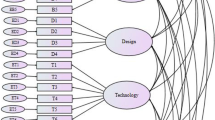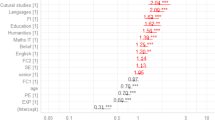Abstract
This study investigated the change in the relationship between pedagogy, computer-use and students’ perceptions about course-effectiveness over time. Students from a Canadian university completed a questionnaire in two different years (2003 = 1,834 participants and 2007 = 1,866 participants). Of greatest interest were characteristics of technology that interact with pedagogy to achieve positive learning outcomes. A factor analysis revealed a three-factor solution: “course-structure,” “active-learning,” and “computer-use.” Multiple regression analysis showed that the three variables are predictive of perceived course effectiveness, with “course-structure” being most predictive in both years. “Computer-use” was least predictive with the 2003 sample while it was second in predictive power with the 2007 sample, most likely reflecting increased technology integration in post-secondary education. When comparing use of various applications in “Arts” versus “Science” courses, results indicated higher computer technology use in 2007 for all applications with arts courses while only web-based computer applications increased in use with the science courses. Separate regression analyses were conducted for each type of program while comparing the two different study years with results indicating that “course-structure” is the most stable predictor. Findings reveal that while pedagogy seems to be of highest importance to students, the relationship between computer use and perceived course effectiveness is changing over time. Implications are discussed and suggestions for future research are presented.
Similar content being viewed by others
References
Internet World Stats. (2010). World Internet Users and Population Stats Retrieved November 15, 2010 from http://www.internetworldstats.com/stats.htm.
APA. (1997). Learner-Centered Psychology Principles: A Framework for School Redesign and Reform. Retrieved March 25, 2005 from http://www.apa.org/ed/lcp.html.
Bayraktar, S. (2001–2002). A meta-analysis of the effectiveness of computer-assisted instruction in science education. Journal of Research on Technology in Education, 34, 173–188.
Bonk, C. J., & Cunningham, D. J. (1998). Searching for learner-centered, constructivist, and sociocultural components of collaborative educational learning tools. In C. J. Bonk & K. S. King (Eds.), Electronic collaborators: Learner-centered technologies for literacy, apprenticeship, and discourse (pp. 25–50). Mahwah, NJ: Erlbaum.
Bonk, C. J., Wisher, R. A., & Lee, J. Y. (2004). Moderating learner-centered E-learning: Problems and solutions, benefits and implications. In T. S. Roberts (Ed.), Online collaborative learning: Theory and practice. Hershey, PA: Information Science Publishing.
Clark, R. E. (1983). Reconsidering research on learning from media. Review of Educational Research, 53(4), 445–449. doi:10.2307/1170217.
Clark, R. E. (1994). Media will never influence learning. Educational Technology Research and Development, 42(2), 21–29. doi:10.1007/BF02299088.
Clark, R. E. (2001). Learning from media: Arguments, analysis evidence. Greenwich CT: Information Age Publishers Inc.
Clark, R. E., Yates, K., Early, S., & Moulton, K. (2009). An analysis of the failure of electronic media and discovery-based learning: Evidence for the performance benefits of guided training methods. In K. H. Silber & R. Foshay (Eds.), Handbook of training and improving workplace performance, Volume I: Instructional design and training delivery. Washington, DC: International Society for Performance Improvement.
Cobb, T. (1997). Cognitive efficiency: Toward a revised theory of media. Educational Technology Research and Development, 45(4), 21–35. doi:10.1007/BF02299681.
Cohen, P. A. (1981). Student ratings of instruction and student achievement: A meta-analysis of multisection validity studies. Review of Educational Research, 51, 281–309. doi:10.2307/1170209.
Collins, A., & Halverson, R. (2009). Rethinking education in the age of technology: The digital revolution and schooling in America. New York, NY: Teachers College Press.
d’Apollonia, S., & Abrami, P. C. (1997). Navigating student ratings of instruction. American Psychologist, 52, 1198–1208.
Dede, C. (1996). The evolution of distance education: Emerging technologies and distributed learning. American Journal of Distance Education, 10(2), 4–36. doi:10.1080/08923649609526919.
Jacobson, M. (1998). Adoption patterns of faculty who integrate computer technology for teaching and learning in higher education. Retrieved March 15, 2005 from http://www.ucalgary.ca/~dmjacobs/phd/phd-results.html.
Jonassen, D. H. (1995). Computers as cognitive tools: Learning with technology, not from technology. Journal of Computing in Higher Education, 6(2), 40–73.
Jonassen, D. H. (2003). Using cognitive tools to represent problems. Journal of Research on Technology in Education, 35(3), 362–381.
Kirschner, P. A., & ErKens, G. (2006). Cognitive tools and mindtools for collaborative learning. Journal of Educational Computing Research, 35(2), 199–209.
Kozma, R. (1994). Will media influence learning: Reframing the debate. Educational Technology Research and Development, 42(2), 7–19. doi:10.1007/BF02299087.
Lambert, N. N., & McCombs, B. L. (Eds.). (1998). How students learn: Reforming schools through learner-centered education. Washington, DC: APA Books.
Laurillard, D. (2002). Rethinking university teaching: A framework for the effective use of educational technology (2nd ed.). London: Routledge.
Linn, M. C., Davis, E. A., & Bell, P. (Eds.). (2004). Internet environment for science education. Mahwah, NJ: Lawrence Erlbaum Associates.
Lowerison, G., Sclater, J., Schmid, R. F., & Abrami, P. C. (2005). Are we using technology for learning. Journal of Educational Technology Systems, 34(4), 401–425.
McCombs, B. L. (2000). Assessing the role of educational technology in the teaching and learning process: A learner-centered perspective. Retrieved September 15, 2005 from http://www.ed.gov/rschstat/eval/tech/techconf00/mccombs_paper.html.
McCombs, B. L., & Vakili, D. (2005). A learner-centered framework for E-learning. Teachers College Record, 107(8), 1582–1600.
Perry, R. P., & Smart, J. C. (Eds.). (1997). Effective teaching in higher education: Research and practice. New York: Agathon.
Ringstaff, C., & Kelley, L. (2002). The learning return on our educational technology investment. San Francisco: WestEd.
Schmid, R. F., Bernard, R. M., Borokhovski, E., Tamim, R. M., Abrami, P. C., Wade, A., et al. (2009). Technology’s effect on achievement in higher education: A stage I meta-analysis of classroom applications. Journal of Computing in Higher Education, 21, 95–109.
Schwartz, N. H., & Schmid, R. F. (in press). Using technology to foster meaningful learning environments. In M. J. Lawson & J. R. Kirby (Eds.), The quality of learning: Dispositions, instruction, and mental structures. Cambridge, England: Cambridge University Press.
Selwyn, N. (2007). The use of computer technology in university teaching and learning: A critical perspective. Journal of Computer Assisted Learning, 23(2), 83–94.
Shuell, T. J., & Farber, S. L. (2001). Student perceptions of technology use in college courses. Journal of Educational Computing Research, 24, 119–138.
Tabachnick, B. G., & Fidell, L. S. (2001). Using multivariate statistics (5th ed.). Boston, MA: Pearson.
Tamim, R. M., Bernard, R. M., Borokhovski, E., Abrami, P. C., & Schmid, R. F. (2011). What forty years of research says about the impact of technology on learning: A second-order meta-analysis and validation study. Review of educational research. doi:10.3102/0034654310393361. Available at http://rer.sagepub.com/content/early/2011/01/09/0034654310393361.
Tamim, R. M., Lowerison, G., Schmid, R. F., Bernard, R. M., Abrami, P. C., & Dehler, C. (2008). Assessing computer use and perceived course effectiveness in post-secondary education in an American/Canadian context. Journal of Educational Computing Research, 39(3), 221–234.
Tamim, R., Schmid, R., & Lowerison, G. (2006, May). Computer use in post-secondary education and students’ perception of its effectiveness. Paper presented at the Association for Media and Technology in Education in Canada, Montreal.
Author information
Authors and Affiliations
Corresponding author
Rights and permissions
About this article
Cite this article
Tamim, R.M., Lowerison, G., Schmid, R.F. et al. A multi-year investigation of the relationship between pedagogy, computer use and course effectiveness in postsecondary education. J Comput High Educ 23, 1–14 (2011). https://doi.org/10.1007/s12528-010-9041-4
Published:
Issue Date:
DOI: https://doi.org/10.1007/s12528-010-9041-4




